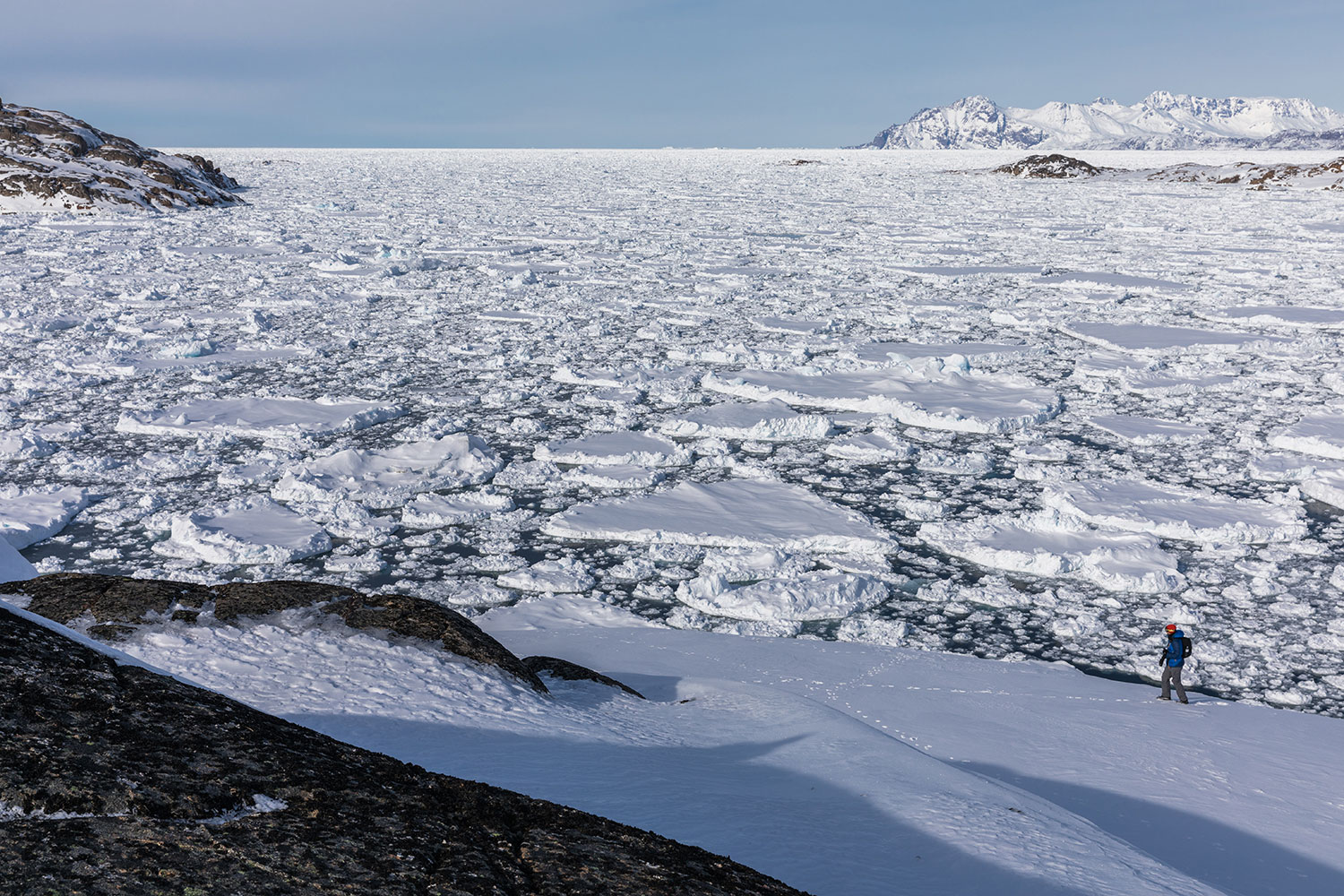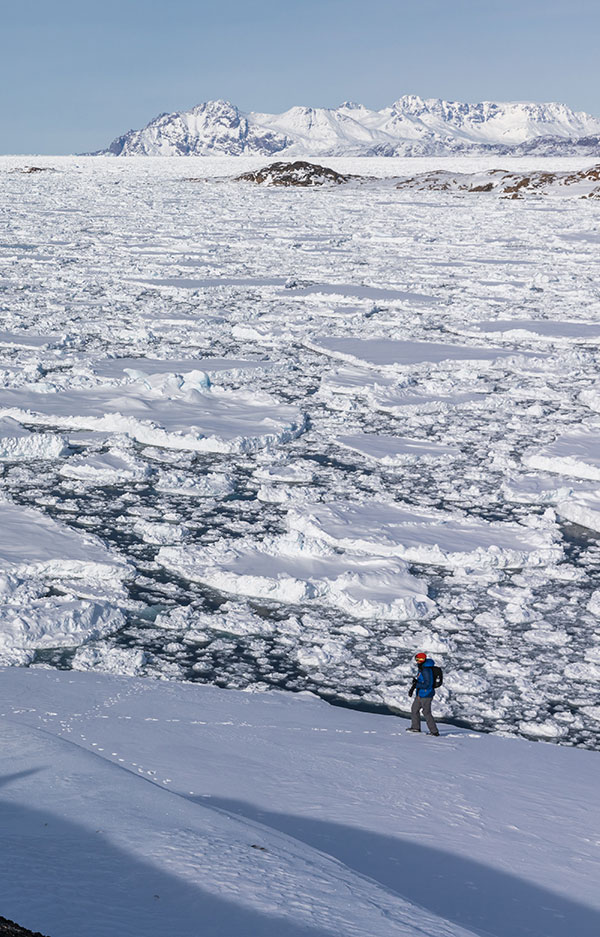

THE ROUTE
Travel through the fjords north of our lodge, crossing sea ice and snowy islands, on a journey into the heart of this wild land.
SETTING OUT
From our lodge, we'll set out to traverse the low hills and broad ridges of the island, looking to familiarise ourselves with the skills and systems we use in the arctic during the winter months. From our highpoints we look out over the pack ice and icebergs of the Denmark Strait. The landscape is complex and intricate, and we'll pick our way through aiming for the most efficient route.
JOURNEY INTO THE FROZEN FJORDS
We'll cover the next stage of the journey by dog sled - the hunters and their dog teams travelling out from Kulusuk to meet us. Sleds loaded, we'll set out across the ice; it’s normal for everyone to travel sitting down, the hunter using voice calls and commands to steer the sled, only standing on the back in more intricate terrain or when going downhill.
Heading out across Tuno gives us our first insight into sea ice conditions, and we’ll carefully observe the ice to learn what we can for the rest of our journey. The fjords around Kulusuk provide rich hunting and fishing grounds, and we may stop to check a seal net or to hunt at the ice edge before continuing to our camp on the flanks of Apusiaajik island. Here the hunters will leave us and travel back across the ice to Kulusuk.
ICEBERGS AND SEA ICE
As we continue on foot, sea ice conditions will vary and we’ll use routes passed down by generations of hunters, combining that with what we see underfoot, to ensure we’re travelling on the best ice. We aim to make steady progress, interspersed by regular breaks to hydrate and take on food – getting into a rhythm is key to covering ground and forming an efficient team.
Ice and weather conditions will all play a key part in our planning and in deciding how far into the fjords we travel, and we may choose to spend some time exploring the mountainous islands which characterise this part of the coast.
VALLEYS AND PASSES
Our route back toward Kulusuk takes us over low cols and through steep-sided valleys, often the crux of the route in deep snow.
We’ll spend our final night camped in this valley system, before one last ascent brings us to a pass and our access back to the sea ice. Here we meet the hunters for the journey back to Kulusuk and a night at the lodge before walking back to the airstrip for your flight out to Iceland.


OUR LODGE
A traditional wooden cabin we have built ourselves over the years, our lodge is nestled in the tiny Inuit village of Kulusuk, home to 200 people.
A comfortable and practical base to explore East Greenland, our lodge provides cabin bedrooms, running water, hot showers, and flushing toilets, a rare thing in this cold climate. There’s a drying area for kit, a sitting room heated by a stove and a big table we all gather around each evening. Cut off by sea ice six months of the year, our stores and freezers are well supplied to provide a plentiful and varied menu. Whenever possible, we eat locally caught fish, from salmon to arctic char, cod and halibut.


WHO IS THIS TRIP FOR...
This trip is for hikers who want to explore the arctic when there’s snow on the ground. You’ll want to be comfortable hiking for 6 – 8 hours a day, covering up to around 15km. Whilst the terrain is generally flat or low-angled, the main physical challenge comes from covering distance in snowshoes whilst pulling a sled with our supplies. Camping and winter walking experience is an advantage but is not a pre-requisite, it's more important that you're up for learning and getting involved in all aspects of the expedition.
GUIDING
We are a small and dedicated team of internationally qualified UIMLA Mountain Leaders who are also passionate adventurers, skiers and mountaineers. As specialists, we encompass over 20 years' experience here in East Greenland. We have great respect for this remote region, carefully managing the unique risks this environment presents. Our safety record is a result of this focus.


TERRAIN AND TRAVEL
Sea ice from the Arctic Ocean pushes down our coastline on the East Greenland current, packing into the fjords and dampening any ocean swells. Combined with long periods of sustained cold temperatures, 'fast ice' (sea ice which is locked in by the surrounding land) begins to form in the inner fjords. Typically forming in early- to mid-winter, this vast area of ice is normally at its greatest extent through March and April, providing the hunters with access deep into the fjords.
This cover of ice provides the means for us to thread an intricate route through the fjords, moving seamlessly from the ice to the land, across islands and passes. An ever-changing medium, the ice continually reacts to prevailing conditions and we could experience anything from hard ice (more typical early season) to a covering of deep snow. The islands are alpine in nature, steep peaks surrounded by extensive glaciation, with only the outer islands largely free of permanent ice - we'll weave a way through the these rolling hills, valleys and passes, our backdrop alternating between seemingly endless sea ice and 'bergs, and the mountain ranges which stretch for hundreds of kilometres up the coast.
GETTING TO GREENLAND
To come visit us on this remote coastline, we’re best reached via Iceland, only 1 hr 40 mins away by turbo prop-plane.
Keflavik, Iceland’s international airport is a hub for North America and Europe and also the starting point for flights to our local airstrip in Kulusuk.
Seats on these Icelandair-operated flights are in short supply and book out early. Whilst we don’t organise flights ourselves, travel agent VR Travel aims to reserve tickets for all our trips and can assist with international connections. You can also book direct with Icelandair.



